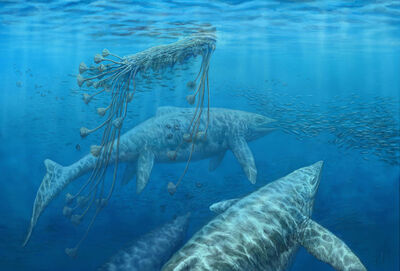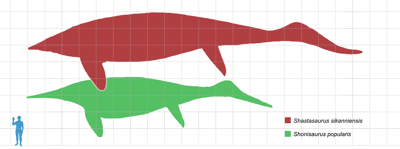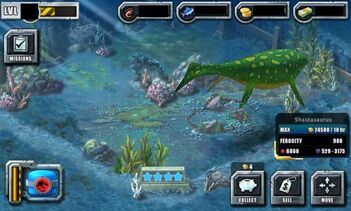(Adding categories) |
(Adding categories) |
||
| Line 57: | Line 57: | ||
[[Category:Aquatic animals]] |
[[Category:Aquatic animals]] |
||
[[Category:Predators]] |
[[Category:Predators]] |
||
| + | [[Category:Dinosaur King creatures]] |
||
Revision as of 10:02, 1 December 2019
| Shastasaurus | ||||
|---|---|---|---|---|
 | ||||
| Name | Shastasaurus | |||
| Class | Sauropsida | |||
| Superorder | Ichthyopterygia | |||
| Order | Ichthyosauria | |||
| Family | Shastasauridae | |||
| genus | Shastasaurus | |||
| Name Translation | "Mount Shasta lizard" | |||
| Period | Late Triassic | |||
| Diet | Fish, squids, and smaller marine reptiles | |||
| Length | 21 meters | |||
Shastasaurus ("Mt. Shasta lizard") is an extinct genus of ichthyosaur from the middle and late Triassic, and is the largest marine reptile that has yet been found, until 2018. The Lilstock Monster was measured to be around the size of a Blue Whale. Specimens have been reported from the United States, Canada, and China. It has been interpreted as a specialised suction-feeder on unshelled cephalopods and fish.
Description
Shastasaurus lived during the late Triassic period. S. sikanniensis is known from the Pardonet Formation British Columbia, dating to the middle Norian age (about 210 million years ago). The largest species, S. sikkanniensis, measured 21 metres (69 ft).

Shastosaurus red; Shonisaurus green
Shastasaurus was highly specialized, and differed considerably from other ichthyosaurs. It was very slender in profile. The largest specimens had a ribcage slightly less than 2 metres (6.6 ft) deep despite a distance of over 7 metres (23 ft) between its flippers. Its skull bore an unusually short, toothless snout compared to the long, toothed, dolphin-like snouts of most ichthyosaurs. It is likely that this strange snout indicates that Shastasaurus was a suction feeder, feeding primarily on soft-bodied cephalopods which lacked shells. In S. liangae, the only species with several well preserved skulls, the skull measures only 8.3% of the total body length (9.3% in a juvenile specimen). Unlike the related Shonisaurus, even juvenile Shastasaurus completely lacked teeth. The snout was highly compressed via a unique arrangement of skull bones. Unlike almost all other reptiles, the nasal bone, which usually forms the mid part of the skull, extended to the very tip of the snout, and all bones of the snout tapered to abrupt points. Shastasaurus was also traditionally depicted with a dorsal fin, a feature found in more advanced ichthyosaurs. However, other shastasaurids likely lacked dorsal fins, and there is no evidence to support the presence of such a fin in any species. The upper fluke of the tail was probably also much less developed than the shark-like tails found in later species.
Species and Synonyms

Shonisaurus sikkannienis, now recognized as a species of Shastasaurus.
The type species of Shastasaurus is S. pacificus, from the late Carnian of northern California. It is known only from fragmentary remains, which have led to the assumption that is was a 'normal' ichthyosaur in terms of proportions, especially skull proportions. Several species of long-snouted ichthyosaur were referred to Shastasaurus based on his misinterpretation, but are now placed in other genera (including Callawayia and Guizhouichthyosaurus). Shastasaurus liangae was the first species to definitively show the unusual short-snouted, toothless nature of Shastasaurus. It is known from several good specimens, and was originally placed in the separate genus Guanlingsaurus. The largest specimen (YIGMR SPCV03109) measures 8.3 metres (27 ft) long. A juvenile specimen (YIGMR SPCV03108) has also been found, measuring 3.74 metres (12.3 ft) in length. S. sikkanniensis was originally described in 2004 as a large species of Shonisaurus. However, this classification was not based on any phylogenetic analysis, and the authors also noted similarities with Shastasaurus. The first study testing its relationships, in 2011, supported the hypothesis that it was indeed more closely related to Shastasaurus than to Shonisaurus, and it was reclassified as Shastasaurus sikkanniensis. Specimens belonging to S. sikanniensis have been found in the Pardonet Formation British Columbia, dating to the middle Norian age (about 210 million years ago). In 2009, Shang & Li reclassified the species Guizhouichthyosaurus tangae as Shastasaurus tangae. However, later analysis showed that Guizhouichthyosaurus was in fact closer to more advanced ichthyosaurs, and so cannot be considered a species of Shastasaurus. Dubious species that have been referred to this genus include S. carinthiacus (Huene, 1925) from the Austrian Alps and S. neubigi (Sander, 1997) from the German Muschelkalk Synonyms of S. liangae: Guanlingsaurus liangae Yin et al., 2000 Synonyms of S. pacificus: Shastasaurus alexandrae Merriam, 1902 Shastasaurus osmonti Merriam, 1902 S. sikanniensis specimen, Royal Tyrrell Museum Synonyms of S. sikkanniensis: Shonisaurus sikkanniensis Nicholls & Manabe, 2003.
In Popular Culture

Shastasaurus can be created in Jurassic Park: Builder. At first, it could only in the Aquatic card packs purchasable by real money. Since May 27th 2016, it became a DNA tournament limited edition
Template:Rp